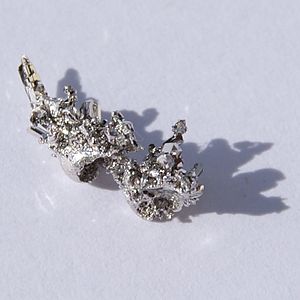From English Wikipedia @ Freddythechick
Chemical element with atomic number 46 (Pd)
Palladium, 46 Pd Pronunciation (pə-LAY -dee-əm Appearance silvery white
Atomic number (Z ) 46 Group group 10 Period period 5 Block d-block Electron configuration [Kr ] 4d10 Electrons per shell 2, 8, 18, 18 Phase at STP solid Melting point 1828.05 K (1554.9 °C, 2830.82 °F) Boiling point 3236 K (2963 °C, 5365 °F) Density (at 20° C) 12.007 g/cm3 [3] when liquid (at m.p. ) 10.38 g/cm3 Heat of fusion 16.74 kJ/mol Heat of vaporization 358 kJ/mol Molar heat capacity 25.98 J/(mol·K) Vapor pressure
P (Pa)
1
10
100
1 k
10 k
100 k
at T (K)
1721
1897
2117
2395
2753
3234
Oxidation states 0 +2 +4 [4] basic oxide)Electronegativity Pauling scale: 2.20 Ionization energies 1st: 804.4 kJ/mol 2nd: 1870 kJ/mol 3rd: 3177 kJ/mol Atomic radius empirical: 137 pm Covalent radius 139±6 pm Van der Waals radius 163 pm Spectral lines of palladiumNatural occurrence primordial Crystal structure face-centered cubic (fcc) (cF4 ) Lattice constant a = 389.02 pm (at 20 °C)[3] Thermal expansion × 10−6 [3] Thermal conductivity 71.8 W/(m⋅K) Electrical resistivity 105.4 nΩ⋅m (at 20 °C) Magnetic ordering paramagnetic [5] Molar magnetic susceptibility × 10−6 3 /mol (288 K)[6] Young's modulus 121 GPa Shear modulus 44 GPa Bulk modulus 180 GPa Speed of sound thin rod 3070 m/s (at 20 °C) Poisson ratio 0.39 Mohs hardness 4.75 Vickers hardness 400–600 MPa Brinell hardness 320–610 MPa CAS Number 7440-05-3 Naming after asteroid Pallas , itself named after Pallas Athena Discovery and first isolationWilliam Hyde Wollaston (1802)
Category: Palladium references
child table, as reused in {IB-Pd}
References These references will appear in the article, but this list appears only on this page.
^ "Standard Atomic Weights: Palladium" . CIAAW . 1979.^ Prohaska, Thomas; Irrgeher, Johanna; Benefield, Jacqueline; Böhlke, John K.; Chesson, Lesley A.; Coplen, Tyler B.; Ding, Tiping; Dunn, Philip J. H.; Gröning, Manfred; Holden, Norman E.; Meijer, Harro A. J. (2022-05-04). "Standard atomic weights of the elements 2021 (IUPAC Technical Report)" . Pure and Applied Chemistry . doi :10.1515/pac-2019-0603 . ISSN 1365-3075 . ^ 3.0 3.1 3.2 Arblaster, John W. (2018). Selected Values of the Crystallographic Properties of Elements . Materials Park, Ohio: ASM International. ISBN 978-1-62708-155-9 ^ Palladium(V) has been identified in complexes with organosilicon compounds containing pentacoordinate palladium; see Shimada, Shigeru; Li, Yong-Hua; Choe, Yoong-Kee; Tanaka, Masato; Bao, Ming; Uchimaru, Tadafumi (2007). "Multinuclear palladium compounds containing palladium centers ligated by five silicon atoms" . Proceedings of the National Academy of Sciences . 104 (19): 7758–7763. doi :10.1073/pnas.0700450104 PMC 1876520 PMID 17470819 .
^ Lide, D. R., ed. (2005). "Magnetic susceptibility of the elements and inorganic compounds". CRC Handbook of Chemistry and Physics (PDF) (86th ed.). Boca Raton (FL): CRC Press. ISBN 0-8493-0486-5 ^ Weast, Robert (1984). CRC, Handbook of Chemistry and Physics . Boca Raton, Florida: Chemical Rubber Company Publishing. pp. E110. ISBN 0-8493-0464-4 ^ 7.0 7.1 Kondev, F. G.; Wang, M.; Huang, W. J.; Naimi, S.; Audi, G. (2021). "The NUBASE2020 evaluation of nuclear properties" (PDF) . Chinese Physics C . 45 (3): 030001. doi :10.1088/1674-1137/abddae . Lua error in mw.title.lua at line 229: too many expensive function calls.


